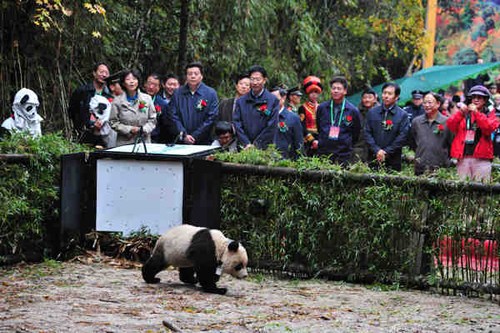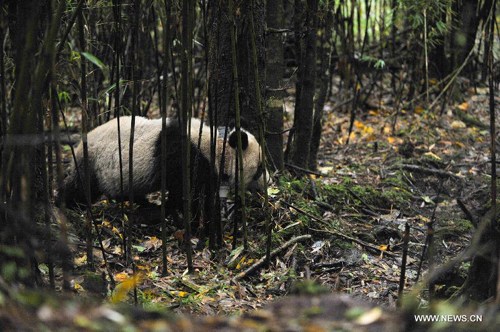
Tao Tao seems to realize that his days of creature comforts are over as he, almost reluctantly, trudges off into the wild at the Liziping Nature Reserve in Sichuan province on Thursday. Heng Yi / for China Daily

Giant panda Tao Tao crawls to the wild mountain forest in the Liziping nature reserve in Shimian County of Ya'an City, southwest China's Sichuan Province, Oct. 11, 2012. As the first artificially raised giant panda released to the nature in China, Tao Tao
A young panda, trained to survive in the wild, was released into the Liziping Nature Reserve in Southwest China on Thursday almost six years after a similar project ended in tragedy.
Two-year-old Tao Tao was reared in captivity since birth at the Wolong National Nature Reserve. He was set free during a morning ceremony hosted by the State Forestry Administration and the Sichuan provincial government. The event drew global media interest.
His release "signifies a new stage of development in China's protection of giant pandas and another important milestone in wildlife protection", said Yin Hong, deputy director of the administration.
Tao Tao was reluctant to leave his cage at first, despite a handler's offer of bamboo stalks. He was eventually coaxed out, and after a few minutes walked down a mountain path, crossed a stream and disappeared into the dense bamboo forest.
For the last two years the cub has received training in surviving in the wild from handlers dressed in panda costumes, and his mother, Cao Cao.
"In September, the State Forestry Administration held a meeting for panda experts who agreed that Tao Tao, who now weighs 42 kg, could be released into the wild," Zhang Hemin, director of administration at Wolong National Nature Reserve, told China Daily. "He's healthy, has the necessary survival skills and a strong sense of self-protection."
Pandas are being released into the wild in an effort to boost their numbers.
China has succeeded in releasing more than 20 species of animals into the wild, including the crested ibis, Chinese alligator, elk, wild horses, Tarim red deer and yellow-bellied tragopan.
"But it's far more difficult to release pandas into the wild due to their low birth rate, uniform diet and fragmented habitat," Zhang added.
Handlers have had to revise training methods based on lessons learned from the fate of Xiang Xiang, a male panda that died in 2007 after being released into the wild.
"Researchers at Wolong have devised a method of allowing mother pandas to take a leading role in training their cubs, which has greatly improved the field training," Zhang said.
Workers at the reserve rescued Cao Cao, now 15, from the wild when she was young. Although she has since lived in captivity, the fact she was raised by her mother in the wild has made her competent to teach Tao Tao how to climb trees when other animals approach and find food under a blanket of snow.
To help cubs identify what will be natural enemies, handlers made a model leopard, complete with a roaring growl. When Tao Tao passed the model during a test in June, he immediately ran for cover.
Six pandas, along with their mothers, are currently receiving field training at Wolong.
"It's hoped two or three each year will be released into the wild," Zhang said.
Mu Shijie, one of Tao Tao's handlers, said: "I don't worry about him not finding food or evading natural enemies. I only worry about him falling ill out there."
A team of experts will be able to track Tao Tao's activities through a GPS tag attached to his collar.
Xiang Xiang was the first panda in Wolong's survival training program, launched in July 2003. At the time he was almost 2 and was considered the strongest candidate as he had never fallen ill in captivity.
Phase one was conducted in an area of 27,000
sq m, 2,080 meters above sea level. During this phase he learned how to find and select the most nutritious bamboo. During the so-called parasite season, he climbed tall trees and stayed in relatively dry places.
Fourteen months later, Xiang Xiang was moved to an area of 240,000 sq m and 2,480 meters above sea level. Workers showed him videos of lions and leopards so he would recognize natural enemies. He was also shown footage of pandas of various sizes and ages to help him better understand his position in the hierarchy.
After almost three years, the panda was taken into the mountainous Wuyipeng area of Wolong, home to more than 10 wild pandas.
On Dec 13, 2006, the radio positioning system showed Xiang Xiang had suddenly traveled a long distance, unusual behavior for a panda, which is a sedentary animal. Nine days later, researchers found him with injuries on his back and his hind feet.
After receiving treatment at the base, the animal was re-released on Dec 30.
The radio signal again became weak on Jan 7, 2007, and then stopped. Xiang Xiang's body was found in the woods on Feb 19. He had a broken rib, injuries to his ears and a large wound on his back.
Researchers suspected he had taken refuge in a tree after a fight with wild pandas, but then had fallen to his death.
It was a heavy blow to workers at Wolong whose endeavors to return pandas to the wild were later suspended by the Wenchuan earthquake in May 2008.
The reserve's Hetaoping base was destroyed in the magnitude-8 tremor, which killed more than 69,000 people and left 18,000 missing. Its pandas were relocated to the Bifengxia base in nearby Ya'an.
Liziping, a provincial-level reserve approved by the Sichuan government in 2003, is home to 13 wild pandas, according to the third national panda census in 1999 and 2000. The sparse population reduces the chance of conflict for Tao Tao, Zhang said.
Nicolas Brown, a three-time Emmy Award-winning director from the United States, compared sending Tao Tao into the wild with the moon landing.
"As a representative of captive pandas, Tao Tao will explore the wilderness, which is their original home," said Brown, who was camouflaged to prevent him disturbing the panda during the release ceremony.
Qi Dunwu, a researcher at the Chengdu Research Base of Giant Panda Breeding, said he thinks it will take at least 50 years for captive pandas to succeed in finding their real home.
It requires several steps, he said. First, a panda released to the wild must feed itself. Second, it must protect its own territory and find a partner. Third, it must breed. Fourth, its offspring must also breed.
It will take about three generations for those steps, as the lifespan of a panda is 15 to 30 years, Qi added.
China has attached great importance to the protection of pandas and has established 64 giant panda nature reserves in Sichuan, Shaanxi and Gansu provinces, covering 60 percent of panda habitats and more than 70 percent of the wild panda population.
Currently, more than 1,600 pandas live wild in the country.

Copyright ©1999-2011 Chinanews.com. All rights reserved.
Reproduction in whole or in part without permission is prohibited.